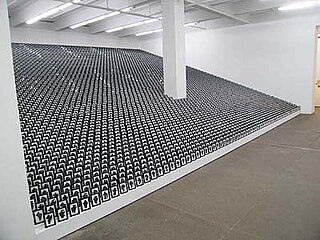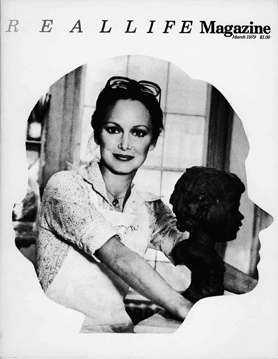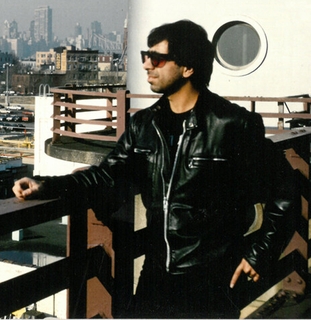Bomb is an American arts magazine edited by artists and writers, published quarterly in print and daily online. It is composed primarily of interviews between creative people working in a variety of disciplines—visual art, literature, film, music, theater, architecture, and dance. In addition to interviews, Bomb publishes reviews of literature, film, and music, as well as new poetry and fiction. Bomb is published by New Art Publications, Inc., a 501(c)(3) non-profit organization.

Peter Halley is an American artist and a central figure in the Neo-Conceptualist movement of the 1980s. Known for his Day-Glo geometric paintings, Halley is also a writer, the former publisher of index Magazine, and a teacher; he served as director of graduate studies in painting and printmaking at the Yale University School of Art from 2002 to 2011. Halley lives and works in New York City.

Neo-conceptual art describes art practices in the 1980s and particularly 1990s to date that derive from the conceptual art movement of the 1960s and 1970s. These subsequent initiatives have included the Moscow Conceptualists, United States neo-conceptualists such as Sherrie Levine and the Young British Artists, notably Damien Hirst and Tracey Emin in the United Kingdom.

Jonathan Lasker is an American abstract painter based in New York City whose work has played an integral role in the development of Postmodern Painting. He is represented by Greene Naftali Gallery, New York.
Just Another Asshole was a no wave mixed media publication project launched from the Lower East Side of Manhattan from 1978 to 1987. Barbara Ess organized and edited seven issues of Just Another Asshole, which formed thanks to an open, collaborative submission process. Issues 3 and 4 were co-edited by Jane M. Sherry and issues 5 through 7 were co-edited by Glenn Branca. Issue formats include: zine, LP record, large format tabloid, magazine, exhibition catalog, and paperback book.
Mary Boone is an American art dealer and collector. As the owner and director of the Mary Boone Gallery, she played an important role in the New York art market of the 1980s. Her first two artists, Julian Schnabel and David Salle, became internationally known, and in 1982 she had a cover story on New York magazine tagged "The New Queen of the Art Scene". Boone is credited with championing and fostering dozens of contemporary artists including Eric Fischl, Ai Wei Wei, Barbara Kruger, Laurie Simmons, Peter Halley, Ross Bleckner, and Jean-Michel Basquiat. Originally based in SoHo, Boone operated two galleries, one on Fifth Avenue, the other in Chelsea. Following her 2019 conviction and sentencing to 30 months in prison for tax evasion, she indicated the intention to close both galleries.
Richard Milazzo is a critic, curator, publisher, independent scholar and poet from New York City. In the 1970s, he was the editor and co-publisher of Out of London Press. He is the co-founding publisher and editor of Edgewise Press. In the 1980s, under the rubric of Collins & Milazzo, he co-curated numerous Collins & Milazzo Exhibitions and co-wrote with Tricia Collins essays on art and art theory.

REALLIFE Magazine was a publication featuring written and visual material by and about young artists that was co-founded and published by artist Thomas Lawson and writer Susan Morgan between 1979 and 1994. It served as a clearing house for new ideas and examinations of mass media and art, while chronicling New York's developing postmodern alternative art scene. It was strongly associated with The Pictures Generation group of artists.
Talent (1986), is a photographic work by David Robbins comprising eighteen photographs that depict contemporary artists such as Cindy Sherman, Jeff Koons, Jenny Holzer, Robert Longo, Michael J Byron, and thirteen others using the headshot portraits long-utilized by the entertainment industry.
The Pictures Generation, 1974–1984 was an exhibition at The Metropolitan Museum of Art in New York City that ran from April 29 – August 2, 2009. The exhibition took its name from Pictures, a 1977 five person group show organized by art historian and critic Douglas Crimp (1944–2019) at New York City's Artists Space gallery. The artists exhibited from September 24 to October 29, 1977 were Troy Brauntuch, Jack Goldstein, Sherrie Levine, Robert Longo and Philip Smith.

Peter Nagy is an American artist known for his post-conceptual art of the 1980s and as an active art gallerist. He is the owner of Gallery Nature Morte, which was founded in New York City's East Village in 1982 and was part of the Collins & Milazzo exhibitions sensual conceptualism scene. It closed in 1988, and in 1992, Nagy moved to New Delhi, India, where Gallery Nature Morte is now located.
The Richard Kuhlenschmidt Gallery was a contemporary art gallery originally located in Los Angeles, California, USA. It played an important part in setting the stage for Los Angeles' emergence as an international art center in the 1980s. It opened in 1982 and eventually closed in 1993 but it was preceded by Jancar Kuhlenschmidt Gallery that put down most of the ground work for what would follow.

Steven Parrino (1958–2005) was an American artist and musician associated with energetic punk nihilism. He is best known for creating big modernist monochrome paintings that he violently slashed, torn or twisted off their stretchers. He died in a motorcycle traffic accident in Greenpoint, Brooklyn at the age of 46.
Post-conceptual, postconceptual, post-conceptualism or postconceptualism is an art theory that builds upon the legacy of conceptual art in contemporary art, where the concept(s) or idea(s) involved in the work takes some precedence over traditional aesthetic and material concerns. The term first came into art school parlance through the influence of John Baldessari at the California Institute of the Arts in the early 1970s. The writer Eldritch Priest, specifically ties John Baldessari's piece Throwing four balls in the air to get a square from 1973 as an early example of post-conceptual art. It is now often connected to generative art and digital art production.
Tricia Collins is an American art critic, art gallerist and curator of contemporary art. She was half of the curatorial team Collins & Milazzo, with Richard Milazzo, who together co-published and co-edited Effects : Magazine for New Art Theory from 1982 to 1984. She later ran the art galleries Grand Salon, Tricia Collins Grand Salon, and Tricia Collins Contemporary Art in New York City until the year 2000.
Kevin Larmon is an American artist and was assistant monitor of painting at Syracuse University.
Gretchen Bender was an American artist who worked in film, video, and photography. She was from the so-called 1980s Pictures Generation of artists, which included Cindy Sherman, Robert Longo, Jack Goldstein, Laurie Simmons and Richard Prince, and who mixed elements of Conceptual Art and Pop Art using images from popular culture to examine its powerful codes.
The Collins & Milazzo exhibitions were a series of art exhibitions curated by the team Tricia Collins and Richard Milazzo, mainly in New York in the mid-1980s to early 1990s.
Neo-geo or Neo-Geometric Conceptualism was an art movement from the 1980s that utilizes geometric abstraction and criticizes the industrialism and consumerism of modern society. The usage of the term neo-geo began when it was first used in reference to a 1986 exhibition at the Sonnabend Gallery in SoHo that included the artwork of Ashley Bickerton, Jeff Koons, Peter Halley and Meyer Vaisman. According to artist Michael Young, Neo-geo artwork recognizes technology as both a promise and a threat.






